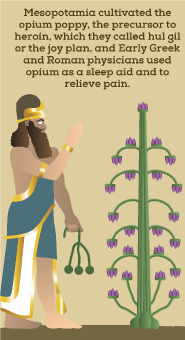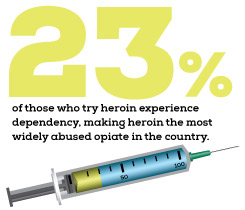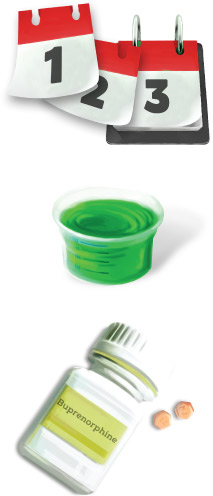Almost 1 million Americans — about 966,000 people — struggle with heroin dependency, according to statistics from the National Institute on Drug Abuse. More than 4.2 million Americans, or about 1.6 percent of the population, have used heroin at least once in their lives. Almost 25 percent of those who try the drug experience dependency, making heroin the most widely abused opiate in the country.
But heroin use isn’t just prevalent in the U.S.: Around the world, more than 9.2 million people use heroin. In Europe, four of every five drug-related deaths are linked to heroin or other opiates. Read on to learn about this drug’s history, its effects and treatment options.
What is Heroin?
Heroin is synthesized from the sap of the Asian opium poppy (Papaver somniferum), a flowering plant that grows in dry, warm climates in Asia, the Middle East and South America. Poppies produce thick, white sap that dries to form a sticky, dark substance known as opium, a narcotic substance with analgesic properties that forms the base material used in the synthesis of morphine, codeine and heroin.
Heroin may take the form of a dark, tarry substance or a white to brown powder. The drug can be smoked through a pipe, injected into veins or muscles, smoked with marijuana or tobacco, or snorted. Heroin affects the pleasure and pain centers in the brain, leading to euphoric highs and pain relief” as well as a high risk of addiction.
History of Heroin
The opium poppy has a long history of use as a medicinal plant across Asia, Europe and the Middle East. The first known reference to the plant comes from 3,400 B.C.; the ancient Sumerians who populated Mesopotamia cultivated the flower, which they called hul gil or the joy plan, and Early Greek and Roman physicians used opium as a sleep aid and to relieve pain.
Traders carried the opium poppy through the region and as cultivation of the flower increased, so did demand for the opium it produced. Over centuries, poppy production spread from the Mediterranean, into Europe, China and Southeast Asia, where opium use” both medicinal and recreation — continued to grow over the next few centuries.
In 1803, chemists discovered how to extract morphine from opium, creating a painkiller that’s still considered among the most effective analgesics available for severe pain. In 1874, a British researcher accidently left a combination of morphine and the chemical acetic anhydride boiling for a few hours, creating heroin. Five years later, the Bayer pharmaceutical company synthesized heroin in the lab and introduced it commercially for use as a painkiller in 1898.
At this time, the medical community was unaware of heroin’s highly addictive and potentially dangerous properties, though opium smoking had been banned in San Francisco for more than two decades. Physicians commonly prescribed the drug for pain relief and, perhaps ironically, as a treatment for morphine addiction, which was relatively widespread at the time.
In 1903, the rates of heroin addiction had grown to levels the Drug Enforcement Administration describes as “alarming.” In 1924, federal law made all heroin use illegal. Today, heroin is classified as a Schedule I substance, or a drug with “no currently accepted medical use and a high potential for abuse. Schedule I drugs are the most dangerous drugs of all the drug schedules with potentially severe psychological or physical dependence.”
Currently, most of the world’s poppy production is concentrated in a 4,500-mile-long mountainous region that stretches from Central Asia, through Pakistan, Turkey and Afghanistan, and on to Laos and Myanmar/Burma. In 2013, more than 5,500 tons of raw opium were produced in Afghanistan alone” the world’s largest producer — an amount worth $1 billion. Much of that opium is synthesized into heroin and smuggled into the U.S. Purity levels have increased in recent years, with the national purity rate ranging from one to 98 percent, with an average of 35 percent purity.
How Does Heroin Work?
When a user snorts, smokes or injects heroin, the substance has an immediate narcotic effect, acting to:
- Depressing the central nervous system
- Relieving pain
- Decreasing mental function
- Slowing the rate of physical functions like breathing and heartbeat
Heroin creates a short-lived rush of euphoria that lasts for a few minutes, followed by a warm, drowsy state that lasts up to several hours.
Heroin’s structure mimics that of naturally occurring chemicals known as endorphins. The brain produces endorphins in times of pain or stress, helping the body to cope and leading to their nickname as the “natural opiates of the body.”
Endorphins work by preventing certain neurons from firing, which relieves pain and produces a warm, happy or even euphoric feeling during intense physical exercise (think runner’s high) or when experiencing stress or pain. The molecules in morphine — heroin’s base substance — affect the endorphin-receptor sites in much the same way as actual endorphins, relieving pain and creating a rush of euphoria. However, unlike endorphins, humans can actually control the amount of heroin they ingest; it’s very easy to begin craving more and more of this feel-good chemical, which is why heroin is so addictive.
Heroin’s Short-Term Effects
After taking heroin, users feel effects within a few seconds to a few minutes. These may include:
After these initial effects subside, users feel warm, cozy, drowsy and mentally “cloudy.” Known as “being on the nod,” these feelings generally last for four to five hours.
Heroin’s Long-Term Effects
With repeated use over time, heroin users are at risk for a host of medical issues. These may include:
When pregnant women use heroin, the drug also affects the fetus. Heroin use while pregnant may result in a greater chance of miscarriage or premature delivery. Babies who are born to heroin users have a higher risk of low birth rate, cardiovascular and respiratory function issues, as well as an increased risk of sudden infant death syndrome (SIDS). Babies may also be born dependent on heroin and experience neonatal abstinence syndrome, or NAS.
In addition to these side effects, heroin users are also at risk of experiencing serious medical issues related to ingesting impure heroin. Manufacturers and dealers often cut the drug with substances such as sugar, powdered milk, starch or even strychnine or other hazardous substances.
These added substances are virtually impossible to detect before using the heroin. When injected, many added substances don’t dissolve inside the body. Over time, they can build up in blood vessels, leading to clogs, infections and cell death, all of which may result in the sudden death of the user. When snorted or smoked, these additional substances increase the user’s risk of respiratory damage and disease. As each batch of heroin is different, it’s impossible for users to always accurately judge the potency and purity of a dose, which also leads to an increased risk of overdose and death.
Dependence, Tolerance and Addiction
Heroin use over time may lead to dependence and tolerance, which may lead to addiction. The National Institute on Drug Abuse estimates that about 23 percent of heroin users will experience dependence or addiction.
When used regularly, the body adapts to the presences of the drug, thus building up tolerance. Users have to ingest more amounts of heroin to get the desired effects. Higher doses, in turn, lead to greater tolerance and greater dependence. Over time, this leads to addiction.
Dependence occurs because the brain adapts to a regular supply of heroin by adjusting its circuits. When the drug stops coming in, the brain adapts by allowing the neurotransmitters that were inhibited by heroin to start flowing again, creating a chemical imbalance that results in physical symptoms known as withdrawal.
Withdrawal Symptoms
Heroin users that build up tolerance and dependence experience withdrawal symptoms when they reduce the amount of the drug they ingest or stop using altogether. Withdrawal symptoms can start within a few hours of the last usage, but generally begin from eight to 12 hours after the last dose. Withdrawal symptoms may include:
Withdrawal can last anywhere from just a few days up to a month. On average, withdrawal symptoms last for about a week and peak from 24 to 72 hours after ingestion of the last dose of heroin.
In unhealthy users, withdrawal may occasionally lead to death. Pregnant heroin users who go through withdrawal may experience spontaneous abortion. Although heroin withdrawal is rarely fatal in most healthy adults, the process can be debilitating.
Treatment
There are a number of available treatments for heroin addiction, including behavioral modification and medical programs. The most effective treatment method differs from person to person, but all tend to work best when the addiction is addressed sooner than later.
Withdrawal is a first step in many treatment programs.
Assistance helps ease withdrawal symptoms while users transition back to a heroin-free state. While withdrawal isn’t a treatment in and of itself, it helps bridge the gap between heroin addiction and long-term treatment plans.
Sometimes, withdrawal is combined with medical treatments. The synthetic narcotic methadone, one of the most common medical treatments for heroin addiction, has been used for more than three decades. Methadone works by weakly mimicking the effects of heroin in the brain, helping users ease off the drug while reducing cravings. When properly prescribed and used, methadone doesn’t result in intoxication or sedation — users can drive, feel pain and experience emotions. Each dose reduces withdrawal for up to 36 hours; while taking methadone, using heroin doesn’t result in the feelings of euphoria that tend to exacerbate addiction.
A newer treatment option, buprenorphine, works like methadone but has a lower chance of overdose and weaker opiate effects. Buprenorphine also lowers rates of physical dependence and can be administered privately in a doctor’s office, rather than in a clinic.
Other medical treatments include:
- Clonidine may cause sedation
- Lofexidine designed for those undergoing opiate withdrawal
- Naloxone used to counteract overdose
- Naltrexone blocks the effects of opiate and lasts from one to three days
Many treatment programs also utilize cognitive behavioral therapy or contingency management therapy. Cognitive behavioral therapy helps users learn how to change their behavior and thoughts in order to overcome addictions for the long term, while contingency management therapy uses a point system based on behavioral choices.
Treatment programs may use a combination of methods to guide users through the withdrawal process. Successful completion of a treatment program can help heroin users overcome their addiction and go on to enjoy life without opiates.






